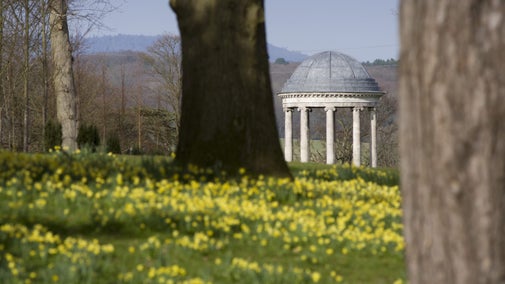
Discover more at Croome
Find out when Croome is open, how to get here, things to see and do and more.

In 1751, George William Coventry, the 6th Earl of Coventry, inherited the Croome estate and commissioned Lancelot ‘Capability’ Brown, to redesign the house and its parkland. Croome was ‘Capability’ Brown’s first large-scale commission and is often described as his 'first and favourite child'. Discover the work that Brown completed which created the Croome that you can see today.
Lancelot 'Capability' Brown (so named for finding the 'capabilities' in his clients’ estates) was the most famous landscape designer and architect of the 18th century. He redesigned hundreds of parks and gardens throughout Britain and developed the natural looking English landscape style, renowned throughout the world.
In 1751, Brown was asked by the 6th Earl to redesign the house and parkland at Croome, which was an unproductive marshland with formal gardens outside the house.
He swept away the local village, which was in view of the house, and rebuilt it further away shrouded by tree planting. He removed Croome’s Medieval church and created a new Gothic church overlooking the park.

Brown remodelled Croome Court into the fashionable Palladian style. He directed the creation of many of the mansion's interiors, plasterwork and decorative schemes, bringing the natural world inside by using flower and fruit motifs.
By 1759 the outer fabric and most of the late Rococo style parts of the interior (Saloon, Drawing Room, Dining Room and Entrance Hall) were finished and Brown moved on to concentrate on the landscape park, perhaps because in 1760 Robert Adam, full of 'modern' Classical ideas, had now come on the scene.
The formal gardens were dug up and, in their place, Brown created natural looking parkland as far as the eye could see, complete with flowering shrubberies to walk through, temples and follies to add interest, carriage drives to ride on, and a hand-dug 1¾ mile long serpentine river topped with a lake.
Brown expertly drained the land by installing a system of culverts across the estate - brick built drains under the ground which fed into the new lake and river.
The estate developed and rivalled Kew Gardens for its variety of plants, many of which were cultivated in a beautiful flower garden and walled kitchen garden before being planted around the grounds. The walled garden was a model of self-sufficiency, feeding the family and their household.
Brown created elaborate illusions in his new landscape – the river was designed to appear as if it drifted off into the distance around a corner, but in fact abruptly came to an end behind some cleverly planted trees and shrubs.
30 years after he started, Brown was still visiting Croome and had become ‘sincere friends’ with the Earl. In February 1783, however, he died whilst returning home from dining with the Earl at his London home.
Their friendship and shared ideals were immortalised in a monument to Brown erected by the 6th Earl at Croome’s lakeside and is still seen today:
'To the Memory of Lancelot Brown
Who by the powers of his inimitable and creative genius formed this garden scene out of a morass.'

Find out when Croome is open, how to get here, things to see and do and more.
Read about Croome's eclectic history, as a home to the 6th Earl and the Coventry family, its time as RAF Defford's airbase, a school for boys, Hare Krishna centre, and the people that helped shape it.

Stretch your legs and take in winter scenes with far reaching views to the Malvern Hills across 'Capability' Brown's first major landscape design project.

Discover more about the privately owned Walled Gardens at Croome, home to large greenhouses, a rose garden and vegetable plots. The Walled Gardens are closed now for 2025 and will reopen weekends and bank holidays 4 April until 27 September 2026 .

Discover the history of the House at Croome, from its beginnings as a mansion house, to its various uses in the 20th century.

Lancelot 'Capability' Brown was one of the UK's most celebrated landscape gardeners. Find out how this Georgian gentleman created the quintessential English landscapes that we see at many of the places in our care today.

Brown designed landscapes that fitted in seamlessly with the surrounding countryside. So how do you spot the designs of one of the greatest gardeners of all time?

Explore estates designed by Lancelot ‘Capability’ Brown, who still defines our view of the British landscape today. Take in serpentine lakes, gothic follies and tree-fringed parkland.
